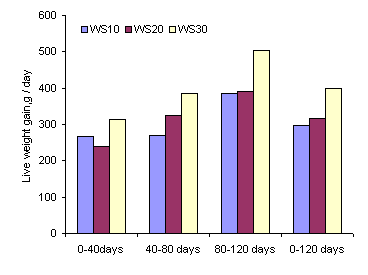| Workshop-seminar, 21-24 August 2006, MEKARN-CelAgrid | Workshop on Forages for Pigs and Rabbits | |||||||||
| Contents |
Effect of different ratios of water spinach and fresh cassava leaves on growth of pigs fed basal diets of broken rice or mixture of rice bran and cassava root meal
Chhay Ty and T R Preston*
Centre for Livestock and Agriculture Development (CelAgrid-UTA
Cambodia)
PO box 2423, Phnom Penh, Cambodia
chhayty@utafoundation.org
*Finca Ecológica, TOSOLY, UTA (Colombia)
AA #48, Socorro, Santander,
Colombia
trpreston@mekarn.org
Abstract
Twenty four crossbred (Local*Landrace or Local*Duroc) castrated male pigs weighing from 16.0 to 18.4 kg were used in a 2*3 factorial arrangement to study the effect of (i) different levels of substitution of wilted cassava leaves by water spinach; and (ii) a basal diet of broken rice or a mixture (50:50) of rice bran and cassava root meal. The feeding trial lasted for 120 days from 8 August to 6 December 2005.
Higher intakes of water spinach and cassava leaves, and of total DM, were observed when the basal diet was broken rice rather than rice bran mixed with cassava root meal. Increasing the replacement of cassava leaves by water spinach from 10 to 30% resulted in increases in intake of the energy component, in the total quantity of foliage, and of total DM. Growth rates tended to be higher on the broken rice diet than on rice bran and cassava root meal; while the 30% level of water spinach was superior to the 10% level.
The overall trend of live weight gain as a function of level of water spinach was curvilinear and positive, indicating a synergistic effect on performance from mixing increasing amounts of water spinach with fresh cassava leaves.
Key words: cassava leaves, growth, broken rice, cassava root
meal, rice bran, pigs, protein, water spinach
Introduction
In a previous experiment (Chhay Ty and Preston 2005) with
growing pigs fed a basal diet of broken rice, we showed that a
supplement of a 50:50 mixture (DM basis) of water spinach
(Ipomoea aquatica) and fresh cassava leaves supported growth
rates that were 32% higher than the average of the growth rates on
the two sources of foliages fed separately. In the present
experiment the hypothesis to be tested was that lower proportions
of water spinach would also have a synergistic effect on growth of
pigs fed low protein basal diets.
Materials and methods
Location
The experiment was carried out from 8 August to 6 December 2005
in the Center for Livestock and Agriculture Development
(CelAgrid-UTA Cambodia), located in Kandal village, Rolous Commune,
Kandal Steung district, Kandal province, about 25km from Phnom Penh
City, Cambodia .
Experimental animals, treatments and design
Twenty four crossbred (Local*Landrace or Local*Duroc) castrated
male pigs with initial body weight from 16 to 18.4 kg were
allocated to six treatments with 4 replicates per treatment in a
2*3 factorial arrangement. The factors were:
Energy
-
Broken rice
-
Cassava root meal mixed with rice bran
Protein supplement
Proportions of water spinach (WS) and fresh cassava leaves
(FCL) in ratios (DM basis) of:
-
WS 10% and FCL 90%
-
WS 20% and FCL 80%
-
WS 30% and FCL 70%
The pigs were allocated into 2 blocks according to live weight
(means for each block were 14.6 and 20.3 kg). The nutritional
treatments were applied at random within each block. The pigs were
housed in individual pens with concrete floors and provided with
feeders and drinking nipples. The pigs were vaccinated against
Salmonella disease and were adapted to the feeds and the housing
for 7 days before starting the experiment.
Feeding and management
Broken rice and rice bran are by-products of Cambodian rice
mills and were available in the local area. Cassava root meal was
purchased from a store in the city. Fresh cassava leaves were
harvested every day from plots in CelAgrid (Photo 1) or they were
purchased from a farmer near the center. The water spinach was
purchased from traders who harvested it from lagoons receiving
waste water from Phnom Penh city.
The leaves plus stems of the water spinach and the leaves of cassava (after removing stems and petioles) were chopped into small pieces and wilted over-night and then mixed with the other ingredients of the diet (Tables 1 and 2) before being offered in 3 meals at 8.00, 12.00 and 17.00h. The amounts of feeds offered were based on the allowance of 40 g DM per 1 kg live weight of the pigs, with the broken rice (or mixture of rice bran and cassava root meal) supplying 50% and the mixtures of leaves providing the remainder.
|
Table 1: Chemical characteristics of the ingredients of the diets |
|||
|
|
DM |
N*6.25 |
HCN |
|
Cassava leaves |
29.8 |
27.1 |
351 |
|
Water spinach |
8.47 |
31.1 |
- |
|
Broken rice |
86.5 |
7.90 |
- |
|
Rice bran |
89.4 |
10.8 |
- |
|
Cassava root meal |
97.2 |
3.12 |
- |
|
Salt |
- |
- |
- |
|
Table 2: Composition (DM basis) and analysis of diets |
||||||
|
|
WS10BR |
WS20BR |
WS30BR |
WS10RBCRM |
WS20RBCRM |
WS30RBCRM |
|
Ingredients, % DM basis |
||||||
|
Water spinach |
10.0 |
20.0 |
30.0 |
10.0 |
20.0 |
30.0 |
|
Cassava leaves |
40.0 |
30.0 |
20.0 |
41.0 |
30.0 |
20.0 |
|
Broken rice |
49.5 |
49.5 |
49.5 |
|
|
|
|
Cassava root meal |
- |
- |
- |
24.0 |
25.0 |
25.0 |
|
Rice bran |
- |
- |
- |
24.5 |
24.5 |
24.5 |
|
Salt |
0.5 |
0.5 |
0.5 |
0.5 |
0.5 |
0.5 |
|
Total |
100 |
100 |
100 |
100 |
100 |
100 |
|
Analysis |
||||||
|
Dry matter, % |
55.6 |
53.5 |
51.3 |
58.3 |
55.9 |
54..7 |
|
N*6.25, % in DM |
17.8 |
18.3 |
18.6 |
17.6 |
17.8 |
18.2 |
|
HCN, mg/kg DM |
14.0 |
10.5 |
3.51 |
14.4 |
10.5 |
3.51 |
Data collection and analyses
The pigs were weighed every 10 days during the trial which lasted 120 days. Individual feeds offered and residues were recorded daily. Samples of feeds and residues were analysed for DM, N and HCN. The DM content was determined using the micro-wave method of Undersander et al (1993). N and HCN were determined following procedures of AOAC (1990).
Statistical analysis
Data for weight gain, DM feed intake, crude protein intake, HCN intake and feed conversion rate were analysed using the general linear model (GLM) option of the ANOVA software of Minitab (2000). The sources of variation were blocks, level of water spinach, energy, interaction energy*level of water spinach and error.
Results and discussion
Feed intake
Higher intakes of water spinach and cassava leaves were observed when the basal diet was broken rice rather than rice bran mixed with cassava root meal (Table 3), with total DM intakes being higher for the former when expressed on a live weight basis. Replacing cassava leaves with water spinach resulted in increases in intake of the energy component, and in the total quantity of foliage, but a decrease in the intake of cassava leaves (Figures 1 and 2).
|
Table 3: Mean values (main effects) for feed intake of pigs fed broken rice or rice bran + cassava root meal supplemented with mixtures of fresh cassava leaves and fresh water spinach |
||||||||||
|
|
Energy |
Level of water spinach |
Interaction |
|||||||
|
|
BR |
RBCRM |
SEM |
Prob. |
WS10 |
WS20 |
WS30 |
SEM |
Prob. |
Prob. |
|
Intake of feed ingredients, g DM/day |
||||||||||
|
RBCRM |
0 |
611 |
|
|
279 |
284 |
352 |
6.28 |
|
|
|
BR |
586 |
0 |
|
|
275 |
277 |
327 |
4.37 |
|
|
|
CL |
310a |
288b |
4.60 |
0.010 |
354a |
279b |
264c |
5.64 |
|
|
|
WS |
264a |
242b |
3.69 |
0.001 |
127 |
248 |
384 |
4.53 |
|
|
| Foliage DM | 575 | 530 | 481 | 528 | 647 | |||||
|
Total DM |
1160 |
1140 |
11 |
0.200 |
1036a |
1089b |
1326c |
13.9 |
0.001 |
0.07 |
|
g/kg LW |
35.2a |
37.3b |
0.190 |
0.001 |
34.2a |
37.0b |
37.6b |
0.23 |
0.001 |
0.033 |
|
N*6.25, g/d |
34.1a |
31.3b |
0.34 |
0.001 |
28.0a |
30.8b |
39.3c |
0.42 |
0.001 |
NS |
|
HCN |
|
|
|
|
|
|
|
|
|
|
|
mg/d |
124a |
115b |
1.45 |
0.001 |
147a |
116b |
96.6c |
1.78 |
0.001 |
0.001 |
|
mg/kg LW |
3.97 |
3.99 |
0.04 |
0.72 |
4.99a |
4.10b |
2.86c |
0.05 |
0.001 |
0.02 |
|
ab Means within main effects within rows without common letter are different at P<0.05 |
||||||||||
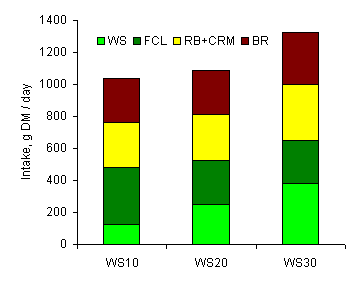
Figure 1: Relative intakes of diet ingredients according
to degree of
substitution of cassava leaves by water spinach
On a live weight basis the HCN levels consumed were 4.99, 4.1 and 2.86 mg/kg LW,
for the water spinach 10, 20 and 30% levels, respectively. These were lower than
in the earlier study (Chhayty et al 2005) and in the range reported as
potentially toxic: 1.4 by Getter and Baine (1938), 2.1 to
2.3 by Johnson and Ramond (1965), 3.5 by Tewe (1992) and 4.4% of LW by Butler (1973).
Growth and feed conversion
Growth rates tended to be higher on the broken rice diet than on rice bran and cassava root meal during the initial, final and overall trial period. For the periods 40 to 80, 80 to 120 and overall, the 30% level of water spinach was superior to the 10% level.
|
Table 4: Mean values for initial and final live weights, and growth rates, of pigs fed broken rice or a mixture of rice bran and cassava root meal supplemented with different levels of water spinach replacing fresh cassava leaves |
|||||||||
|
|
Energy |
Water spinach, % replacement of cassava leaves |
|||||||
|
Days |
BR |
RBCRM |
SEM |
Prob. |
WS10 |
WS20 |
WS30 |
SEM |
Prob. |
| Growth rate, g/day | |||||||||
|
0-40 |
273 |
225 |
16.9 |
0.07 |
234 |
229 |
284 |
20.8 |
0.15 |
|
40-80 |
327 |
293 |
19.3 |
0.24 |
249a |
321ab |
360b |
23.8 |
0.013 |
|
80-120 |
427 |
341 |
18.5 |
0.06 |
3394a |
355a |
456b |
22.6 |
0.004 |
|
0-120 |
337 |
290 |
17.5 |
0.079 |
267a |
306ab |
367b |
21.4 |
0.015 |
| Live weight, kg | |||||||||
| Initial | 17.7 | 17.3 | 0.69 | 0.67 | 18.0 | 16.0 | 18.4 | 0.84 | 0.13 |
|
Fina1# |
58.2 |
50.2 |
2.3 |
0.025 |
49.7a |
52.6a |
60.4b |
2.9 |
0.044 |
|
ab Means within
rows without common letter are different at P<0.05 |
|||||||||
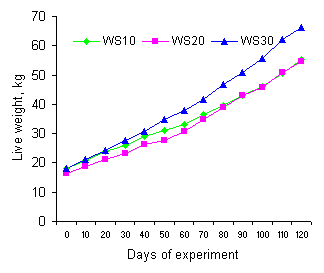 |
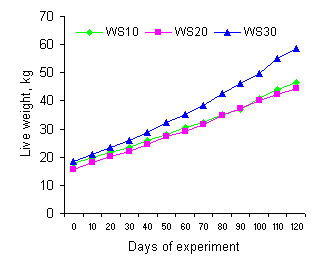 |
|
|
Figure 2: Growth curves of pigs fed basal diet
of broken rice |
Figure 3: Growth curves of pigs fed basal diet
of rice bran and |
|
|
|
|
|
Figure 4: Growth rates of the pigs during successive 40
day periods
and overall, according to supplementary level of water spinach |
Figure 5: Growth rates of the pigs during successive 40
day periods
and overall, according to supplementary level of water spinach |
The overall trend of live weight gain as a function of level of water spinach was curvilinear and positive (Figures 6 and 7), indicating that the rate of increase in live weight gain by replacing cassava leaves with water spinach was more marked the higher the level of water spinach in the diet. The growth curves in Figures 2 and 3 indicate a similar trend.
|
|
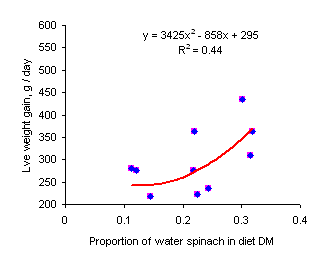 |
|
| Figure 6: Relationship between growth rate and replacement of cassava leaves by water spinach on broken rice diet | Figure 7: Relationship between growth rate and replacement of cassava leaves by water spinach on diet of rice bran and cassava root meal |
Feed conversion was better on the basal diet of broken rice than on the mixture of rice bran and cassava root meal and tended to improve (P=0.12 for the overall trial period) with increasing levels of water spinach (Table 5).
|
Table 5: Mean values for DM feed conversion of pigs fed broken rice or a mixture of rice bran and cassava root meal supplemented with different levels of water spinach replacing fresh cassava leaves |
|||||||||
|
|
Energy |
Level of water spinach |
|||||||
|
Days |
BR |
RBCRM |
SEM |
Prob. |
WS10 |
WS20 |
WS30 |
SEM |
Prob. |
|
0-120 |
3.44 |
4.06 |
0.07 |
0.001 |
3.91 |
3.70 |
3.65 |
0.08 |
0.12 |
|
ab Means within main effects within rows without common letter are different at P<0.05 |
|||||||||
Conclusions
-
The synergistic effect on growth rate of pigs of replacing cassava leaves with water spinach, as the main protein source, was confirmed in that the relative response to substituting cassava leaves with water spinach increased as the degree of replacement was increased.
-
There were no indications of HCN toxicity on any of the diets
Acknowledgments
The authors would like to express their gratitude to the MEKARN
project financed by the SIDA-SAREC Agency, and to the Center for
Livestock and Agriculture Development (CelAgrid UTA-Cambodia), for
providing resources for conducting this experiment
References
AOAC 1990.Official Methods of Analysis. Association of
Official Analytical Chemists. 15th Edition (K Helrick editor).
Arlington pp 1230
BounhongNorachack,SoukanhKeonouchanh,
Chhay Ty, Bounthong Bouahom and Preston T R 2004: Stylosanthes
and cassava leaves as protein supplements to a basal diet of broken
rice for local pigs. Livestock Research for Rural
Development. Vol. 16, Art. # 74. Retrieved
, from http://www.cipav.org.co/lrrd/lrrd16/10/boun16074.htm
ButlerG W 1973Physiological and genetic aspects of
cyanogenesis in cassava and other plants, Chronic cassava toxicity.
Proceedings of the Interdisciplinary Workshop, London England,
29-30 Jan., 1973. IDRC -010e, pp. 65-71
CalpeC 1992Root, tubers and plantains: recent
trends in production trade and use. In: Machin F and Nyvild S
(Editors) Root, tuber, Plantains and Bananas in Animal Feeding.
FAO Animal Production and Health Paper 95, pp. 11-25
Chhay Ty, Preston T R and Ly J 2003:The use of ensiled
cassava leaves in diets for growing pigs. 2. The influence of type
of palm oil and cassava leaf maturity on digestibility and N
balance for growing pigs. Livestock Research for Rural
Development 15 (8).Retrieved June 30, 2005, from http://www.cipav.org.co/lrrd/lrrd15/8/chha158.htm
Chhay Ty and Preston T R 2005:Effect of water spinach
and fresh cassava leaves on intake, digestibility and N retention
in growing pigs. Livestock Research for Rural
Development.Vol. 17, Art. #23.Retrieved
June 30, 2005, from http://www.cipav.org.co/lrrd/lrrd17/2/chha17023.htm
DuThanh Hang and Preston T R 2005The effects of
simple processing methods of cassava leaves on HCN content and
intake by growing pigs. Proceedings of Workshop-seminar "Making
better useof local feed resources" MEKARN-CTU, Cantho, 23-25 May,
2005. http://www.mekarn.org/procctu/hang.htm
EggumB O 1970The protein quality of cassava
leaves. British Journal of Nutrition. 24: 761-768
Getter A O and Baine J 1938Research on cyanide
detoxification. American Journal of Medical Science. pp.
185-189
Johnson R M and Ramond W D 1965The chemical composition
of some Tropical food plants: Manioc. Tropical Science 7, pp.
109-115.
KeanSophea and Preston T R 2001 Comparison of
biodigester effluent and urea as fertilizer for water spinach
vegetable.Livestock
Research for Rural Development 13 (6) http://www.cipav.org.co/lrrd/lrrd13/6/kean136.htm
Ly Thi Luyen and Preston T R 2004: Effect of level of
urea fertilizer on biomass production of water spinach (Ipomoea
aquatica) grown in soil and in water. Livestock Research
for Rural Development.Vol. 16, Art. #81. Retrieved
, from http://www.cipav.org.co/lrrd/lrrd16/10/luye16081.htm
Ly J, Hean Pheap, Keo Saeth and Pok Samkol 2002.The
effect of DL-methionine supplementation on digestibility and
performance traits of growing pigs fed broken rice and water
spinach (Ipomoea aquatica). Livestock Research for Rural
Development (14) 5: http://www.cipav.org.co/lrrd/lrrd14/5/ly145b.htm
Ly J 2002The effect of methionine on digestion indices
and N balance of young Mong Cai pigs fed high levels of ensiled
cassava leaves. Livestock Research for Rural Development. (14) 2:
http://www.cikpav.org.co/lrrd/lrrd14/6/Ly146.htm
MINITAB 2000Minitab Reference Manual release
13.31.
Nguyen Duy Quynh Tram and Preston T R 2004:Effect of
method of processing cassava leaves on intake, digestibility and N
retention by Ba Xuyen piglets. Livestock Research for Rural
Development.Vol.16, Art. # 80. Retrieved
, fromhttp://www.cipav.org.co/lrrd/lrrd16/10/tram16080.htm
Prak Kea, Preston T R and Ly J 2003Feed intake,
digestibility and N retention of a diet of water spinach
supplemented with palm oil and / or broken rice and dried fish for
growing pigs. Livestock Research for Rural Development (15)
8 Retrieved , from http://www.cipav.org.co/lrrd/lrrd15/8/kea158.htm
PrestonT R 2001 Potential of cassava in integrated
farming systems.. International Workshop Current Research and
Development on Use of Cassava as Animal Feed, Khon Kaen, Thailand
July 23-24, 2001. http://www.mekarn.org/procKK/pres.htm
RavindranV,Kornegay E and
Rajaguru E S 1987 Influence of processing methods and
storage time on the cyanide potential of cassava leaf meal. Animal
Feed Science and Technology 17:227-23
TeweO O 1992 Detoxification of casava products and
effecs of residual toxins on consuming animals.In: Roots, tubers,
plantains and bananas in animal feeding. (D. Machin and S. Nyvold,
editors) FAO Animal Production and Health Paper No 95. Rome p
81-98
Tran Hoang Chat, Ngo Tien Dung, Dinh Van Binh and Preston T R
2005 Water spinach (Ipomoea aquatica) as replacement
for guinea grass for growing and lactating rabbits; Workshop-seminar
"Making better use of local feed resources" (Editors: Reg
Preston and Brian Ogle) MEKARN-CTU, Cantho, 23-25 May, 2005.
Article #48. Retrieved , from http://www.mekarn.org/proctu/chat48.htm
UndersanderD, Mertens D R and Theix N 1993 Forage analysis procedures.National Forage Testing Association. Omaha pp 154
